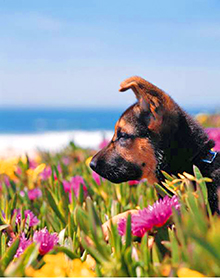Blue Ribbon K9 - Las Vegas Dog Training
The Humane Dog Trainers Of Las Vegas
The Canine Good Citizen Test
Components Of The CGC Test
The Canine Good Citizen Test is a certification program that tests dogs in simulated everyday situations in a relaxed atmosphere. It identifies and rewards dogs that have the training and demeanor to be reliable family members as well as good-standing community members. All dogs passing the Canine Good Citizen Test receive a certificate from the American Kennel Club.
The purpose of the Canine Good Citizen Test is to ensure that our favorite companion, the dog, can be a respected member of the community because it is trained and conditioned to act mannerly in the home, in public places and in the presence of other dogs. The program embraces both pure-bred and mixed-breed dogs.
Canine Good Citizen training is fun and useful. Through it, you and your dog will establish a closer bond and your dog will have the added benefit of knowing how to please you. This test of your dog's manners and training is not a competition and does not require that you and your dog perform with precision.
The American Kennel Club urges all dog owners to participate in this program, thereby assuring that our beloved dogs will always be welcomed and respected members of the community.
Demonstrating Confidence and Control, The Dog Must Complete These Ten Steps:
Test 1: Accepting a Friendly Stranger
This test demonstrates that the dog will allow a friendly stranger to approach it and speak to the handler in a natural, everyday situation. The evaluator and handler shake hands and exchange pleasantries. The dog must show no sign of resentment or shyness and must not break position or try to go to the evaluator.
Test 2: Sitting Politely for Petting
This test demonstrates that the dog will allow a friendly stranger to touch it while it is out with its handler. While the dog is sitting at the handler's side, the evaluator pets the dog on head and body only, then circles the dog and handler, completing the test. The dog must not show shyness or resentment.
Test 3: Appearance and Grooming
This practical test demonstrates that the dog will welcome being groomed and examined and will permit a stranger, such as a veterinarian, groomer or friend of the owner, to do so. It also demonstrates the owner's care, concern and responsibility. The evaluator inspects the dog, then combs or brushes the dog and lightly examines the ears and each front foot.
Test 4: Out for a Walk (Walking on a loose leash)
This test demonstrates that the handler is in control of the dog. The dog may be on either side of the handler, whichever the handler prefers. There must be a left turn, a right turn and an about turn, with at least one stop in between and another at the end. The dog need not be perfectly aligned with the handler and need not sit when the handler stops.
Test 5: Walking Through a Crowd
This test demonstrates that the dog can move about politely in pedestrian traffic and is under control in public places. The dog and handler walk around and pass close to several people (at least three). The dog may show some interest in the strangers, without appearing over exuberant, shy or resentful. The handler may talk to the dog and encourage or praise the dog throughout the test. The dog should not be straining at the leash.
Test 6: Sit and Down on Command/Staying in Place
This test demonstrates that the dog has training, will respond to the handler's command to sit and down and will remain in place commanded by the handler (sit or down position, whichever the handler prefers). The handler may take a reasonable amount of time and use more than one command to make the dog sit and then down. When instructed by the evaluator, the handler tells the dog to stay and walks forward the length of a 20-foot line. The dog must remain in place, but may change positions.
Test 7: Coming When Called
This test demonstrates that the dog will come when called by the handler. The Handler will walk 10 feet from the dog, turn to face the dog, and will call the dog. The handler may use body language and encouragement to get the dog to come. handlers may choose to tell dogs to "stay" or "wait" or they may simply walk away, giving no instructions to the dog as the evaluator provides mild distractions (e.g. petting).
Test 8: Reaction to Another Dog
This test demonstrates that the dog can behave politely around other dogs. Two handlers and their dogs approach each other from a distance of about 10 yards, stop, shake hands and exchange pleasantries, and continue on for about 5 yards. The dogs should show no more than a casual interest in each other.
Test 9: Reactions to Distractions
This test demonstrates that the dog is confident at all times when faced with common distracting situations, such as the dropping of a large book or a jogger running in front of the dog. The dog may express a natural interest and curiosity and may appear slightly startled, but should not panic, try to run away, show aggressiveness or bark.
Test 10: Supervised Separation
This test demonstrates that a dog can be left alone, if necessary, and will maintain its training and good manners. Evaluators are encourage to say something like, "Would you like me to watch your dog?" and a person will hold the leash of the dog. The dog will be held for three minutes and does not have to stay in position, but should not continually bark, whine, howl, pace unnecessarily or show anything other than mild agitation or nervousness.
Free training and behavior evaluations!
To schedule your free dog training evaluation click here!
or contact a trainer today for more information!
Site Last Updated: March 9, 2017


